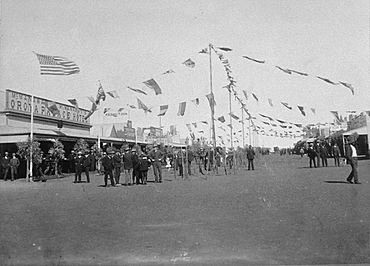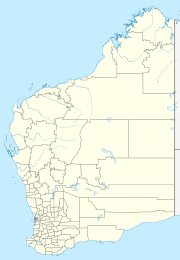Sandstone, Western Australia facts for kids
Quick facts for kids SandstoneWestern Australia |
|||||||||
|---|---|---|---|---|---|---|---|---|---|

Empire Day celebrations in Hack Street, 1909
|
|||||||||
| Established | 1906 | ||||||||
| Postcode(s) | 6639 | ||||||||
| Elevation | 533 m (1,749 ft) | ||||||||
| Area | [convert: needs a number] | ||||||||
| Location |
|
||||||||
| LGA(s) | Shire of Sandstone | ||||||||
| State electorate(s) | North West Central | ||||||||
| Federal Division(s) | Durack | ||||||||
|
|||||||||
Sandstone is a small town in the Mid West region of Western Australia. It is about 157 kilometres (98 miles) east of Mount Magnet. Sandstone is also 661 kilometres (411 miles) north of Perth, the state capital.
In 2016, Sandstone and the area around it had a population of 89 people. This included 19 families. Sandstone is the main town and administrative centre for the Shire of Sandstone local government area.
Contents
How Sandstone Began
Sandstone started because of a big gold discovery. George Dent and the Hack brothers, Wilton and Theodore, found a rich vein of gold. They found it on New Year's Day in 1903 at a mine called The Adelaide. These three men were from South Australia and had spent eight years looking for gold in the area.
News of their discovery spread very quickly. Within a month, people had claimed 60 acres of land around their mine. A town began to form, and many buildings were moved from a nearby place called Nungurra to this new site.
The Adelaide Mine's History
Dent and the Hack brothers sold their mine to Hans Irvine in November 1903. They had dug as deep as they could by hand. All three became very rich from the sale. The mine then became part of the Black Range Mining Company.
Between 1903 and 1916, a huge amount of gold was taken from the mine. About 700 tonnes of ore were dug out, producing 930,000 ounces of gold.
By 1907, Nungurra was a ghost town because everyone had moved to Sandstone. The town of Sandstone was officially named in 1906. The original "Adelaide" mine is only a few hundred metres from the centre of Sandstone today.
The mine was known by many names, like "The Adelaide" and "Hack & Dents Mine." The Hack brothers were remembered by having Sandstone's main street named after them. They also had a miner's cough called "Hack's Cough." George Dent was not as well-remembered, and his family has tried to change this for many years.
Life in Early Sandstone
By 1907, the population of Sandstone grew to between 6,000 and 8,000 people. The town had four hotels, four butchers, and two banks. There was also a police station with staff and many other shops.
An Irishman named I.V. Kearney built a brewery in 1907. He built it to make beer for all the people living there. The brewery was built on top of a 35-foot-high cliff. Water was pumped to the top for brewing. The beer was stored in cool cellars below. This kept it cold even in hot weather.
Transport and Water Supply
In 1910, a railway line was finished. It connected Mount Magnet to Sandstone. This was important for moving goods and people.
The Jundoo Dam was also completed in 1910. It provided water for the steam trains. The dam could hold 3.5 million imperial gallons (16 megalitres) of water. It cost £5,000 to build. Most of the original dam structures are still there today.
At this time, Sandstone had about 2,000 adult residents. It also had two schools for children.
Growing Communities
By 1912, Sandstone's population reached 8,000 people. A nearby town called Youanmi had 300 people. Around this time, the first large farms, called pastoral leases, were set up in the Youanmi area. These included Youanmi Downs, Yuinmery, and Lake Barlee Stations.
Mining and Landmarks
A state-run battery was used to process gold ore. It operated from 1904 to 1982. At first, it was 6 kilometres (3.7 miles) south of town. From 1925, it was moved to a site 900 metres (3,000 feet) to the east. The battery processed over 135,000 tons of ore. This produced more than 115,000 ounces of gold.
A natural rock formation called London Bridge is 3 kilometres (1.9 miles) south of Sandstone. It is a natural bridge and part of the Sandstone Heritage Trail.
Sandstone was the inspiration for a mining town in a 1963 novel. The book was called Tourmaline by Randolph Stow. Of the hotels built in town, only the National Hotel remains. It was built in 1909 from bricks made right there in Sandstone.


